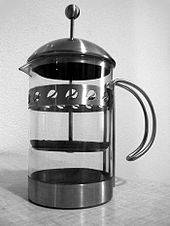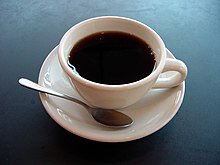Coffeemaker
The examples and perspective in this article may not represent a worldwide view of the subject. (December 2022) |


A coffeemaker, coffee maker or coffee machine is a cooking appliance used to brew coffee. While there are many different types of coffeemakers, the two most common brewing principles use gravity or pressure to move hot water through coffee grounds. In the most common devices, coffee grounds are placed into a paper or metal filter inside a funnel, which is set over a glass or ceramic coffee pot, a cooking pot in the kettle family. Cold water is poured into a separate chamber, which is then boiled and directed into the funnel and allowed to drip through the grounds under gravity. This is also called automatic drip-brew. Coffee makers that use pressure to force water through the coffee grounds are called espresso makers, and they produce espresso coffee.
Types
Vacuum brewers
On 27 August 1930, Inez H. Peirce of Chicago, Illinois, filed her patent for the first vacuum coffee maker that truly automated the vacuum brewing process, while eliminating the need for a stovetop burner or liquid fuels.[1]
Cafetiere

A cafetiere (coffee plunger, French press in US English) requires coffee of a coarser grind than does a drip brew coffee filter, as finer grounds will seep through the press filter and into the drink.[2]
Because the coffee grounds remain in direct contact with the brewing water and the grounds are filtered from the water via a mesh instead of a paper filter, coffee brewed with the cafetiere captures more of the coffee's flavour and essential oils, which would become trapped in a traditional drip brew machine's paper filters.[3] As with drip-brewed coffee, cafetiere coffee can be brewed to any strength by adjusting the amount of ground coffee which is brewed. If the used grounds remain in the drink after brewing, French pressed coffee left to stand can become "bitter", though this is an effect that many users of cafetiere consider beneficial. For a 1⁄2-litre (0.11 imp gal; 0.13 US gal) cafetiere, the contents are considered spoiled, by some reports, after around 20 minutes.[4]
Single-serve coffeemaker
The single-serve or single-cup coffeemaker had gained popularity by the 2000s.[5]
See also

- Arndt'sche Caffee-Aufgussmaschine (including Quedlinburg Kaffee-Aufguss-Maschine) – manual coffee makers
- Benjamin Thompson - inventor of a drip coffeepot
- Coffee biggin – French manual coffee maker
- Büttner filter and Bauscher filter – manual coffee and moka makers utilizing a special type of permanent porcelain filter
- Caffè crema
- Cezve
- Coffee cup
- Coffee percolator
- Coffee pod
- Coffee preparation
- Coffee vending machine
- Coffeepot (François-Thomas Germain)
- French drip coffee pot (including Cafetière du Belloy and Drip-O-lator) – manual coffee makers utilizing various kinds of permanent filters with round holes
- Grègue (café grègue, café coulé) – manual coffee makers
- ISSpresso – the first espresso coffee machine designed for use in space
- Jebena
- Karlsbad coffee maker (including Bohemian coffee pot, Bayreuth coffee maker, and Walküre Aroma-pot) – manual coffee makers utilizing a double-slotted permanent filter of glazed porcelain
- Moka pot – a manual moka maker
- Neapolitan flip coffee pot (and variants like the Russian egg, Potsdam boiler, or the Arndt'sche Sturzmaschine) – manual coffee makers
- Trojan Room coffee pot
References
- ^ "Patent drawing". Retrieved 6 February 2013.
- ^ "Manual brewing techniques give coffee lovers a better way to make a quality drink". www.post-gazette.com. Retrieved 14 May 2018.
- ^ "Coffee Brewing - CoffeeResearch.org". www.coffeeresearch.org. Retrieved 14 May 2018.
- ^ Rinsky, Laura Halpin (2008). The Pastry Chef's Companion. John Wiley and Sons. p. 119. ISBN 978-0-470-00955-0.
- ^ Gara, Tom (28 November 2012). "The K-Cup Patent Is Dead, Long Live The K-Cup". WSJ. Retrieved 14 May 2018.
External links
 Media related to Coffeemaking implements at Wikimedia Commons
Media related to Coffeemaking implements at Wikimedia Commons
- Articles with short description
- Short description is different from Wikidata
- Use dmy dates from April 2023
- Articles with limited geographic scope from December 2022
- Articles containing French-language text
- Commons category link is locally defined
- Articles with GND identifiers
- Articles with NKC identifiers
- Coffeeware
- Cooking appliances
- Boilers (cookware)
- Culture of the United States
- 18th-century inventions